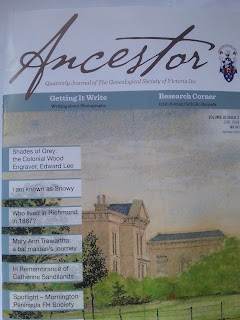JOHN BECKWITH ANDERSON
From SCOTLAND to AUSTRALIA to RHODE ISLAND, USA in the 1800's.
One of the things I really love about doing Family History research, is the people you come into contact with who are pursuing the same information.
I came to know about the Anderson family, who lived in Chewton, Victoria, Australia. They were next-door neighbours to my ancestors, the Cadwalladers. William Cadwallader was the blacksmith of Chewton, and I have written about the Cadwalladers before, on 3 October 2015, under the title Harriet Cadwallader nee Sloane 1839-1920.
The Andersons emigrated from Scotland to Australia aboard the Athletae in 1855. Coincidentally, so did another but unrelated branch of my family tree, the Strachan family. The Strachan's baby daughter Ann died on the voyage and was buried at sea. Duncan and Agnes Stevens ANDERSON (nee Beckwith) travelled with their two children, John aged 3 and Mary aged 1, the same age as Ann who died. Duncan and Agnes must have known and grieved with the Strachans and probably attended Ann's burial at sunset on New Year's Day, 1855. What must 3 year-old John have thought?
While the Strachans settled in Port Fairy, then known as Belfast, the Andersons travelled on and settled in Chewton. They went on to have 9 children. Duncan himself was a builder.
There was a land auction in Chewton in 1860, and William Cadwallader and his father-in-law James Salter probably stood side by side as they bid on their properties. Duncan Anderson was there too, as he bought the property on Fryer's Road beside William's that day. Lots of gold rush money was spent buying property in 1860.
The Andersons prospered in Chewton until 1869, when they moved to Ascot Vale in Melbourne.
We are searching for JOHN (BECKWITH) ANDERSON, the eldest son of Duncan and Agnes, born in Edinburgh, Scotland on 7 Jan 1851. He was quite possibly William Cadwallader's blacksmith's apprentice.
We know he turns up at Rhode Island in the US at age 19 in the 1870 Census. He is listed as an apprentice Blacksmith. Also located there is his maternal uncle, Stevens Beckwith, who is a silversmith with Gorham Silver. We can find no record of John after 1870.
We would love to find out what happened to John Anderson after 1870. If anybody has further information on John, please get in touch with me and I will forward the information to his family.
https://www.victorianplaces.com.au/chewton
https://chewton.net/history/



































